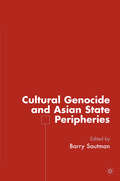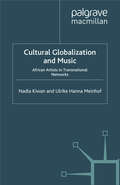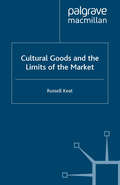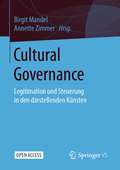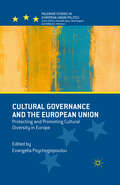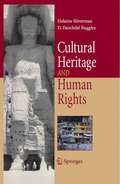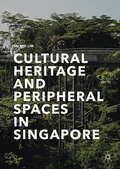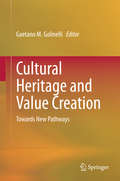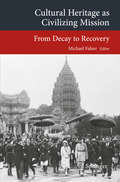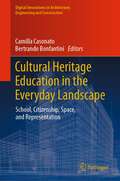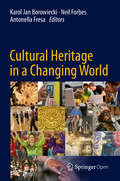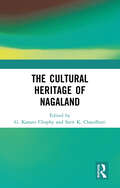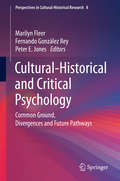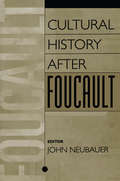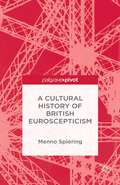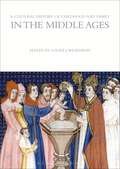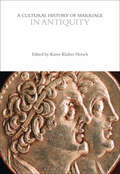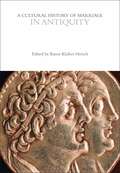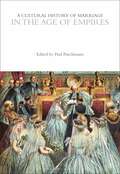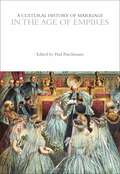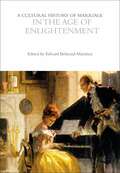- Table View
- List View
Cultural Genocide and Asian State Peripheries
by B. SautmanThis volume engages the concept and related notions of cultural hegemony, cultural erosion, cultural hybridity and cultural survival by considering whether five regimes in Asia deploy policies aimed at extirpating the language, religion, arts, customs or other elements of the cultures of non-dominant peoples.
Cultural Globalization and Music: African Artists in Transnational Networks
by Nadia Kiwan Ulrike Hanna MeinhofThis book is about South-North, North-South relations between Africa and Europe, presenting the personal narratives of musicians in different locations across Africa and Europe, and those of the people who constitute their networks within the wider artistic, cultural, and civil society milieus of globalizing societies.
Cultural Goods and the Limits of the Market
by R. KeatIn Cultural Goods and the Limits of the Market , Russell Keat presents a theoretical challenge to recent extensions of the market domain and the introduction of commercially modelled forms of organization in areas such as broadcasting, the arts and academic research. Drawing on Walzer's pluralistic conception of social goods, and MacIntyre's account of social practices, he argues that cultural activities of this kind, and the institutions within which they are conducted, can best make their distinctive contributions to human well-being when protected from the damaging effects of an unbounded market.
Cultural Governance: Legitimation und Steuerung in den darstellenden Künsten
by Birgit Mandel Annette ZimmerIm internationalen Vergleich verfügt Deutschland über einen bemerkenswerten Theatersektor im Hinblick auf Ensembles und Spielstätten. Die darstellenden Künste sind zudem der Kulturbereich mit der höchsten öffentlichen Förderung. Theater ist daher in besonderer Weise abhängig von der Politik. Was bedeutet das für den Alltag der Theatermacher*innen? Wie und mit welchen Zielsetzungen greift Kulturpolitik in die darstellenden Künste ein? Welche Governance-Strukturen lassen sich erkennen? Antworten auf diese Fragen geben Ergebnisse der DFG-Forschungsgruppe „Krisengefüge der Künste“, die das Zusammenspiel von Politik, Organisation und künstlerischer Produktion untersucht. Die Beiträge dieses Open Access Buches decken ein breites Themenspektrum ab, das von Fallbeispielen kulturpolitischer Governance und Legitimationsstrategien einzelner Häuser, über empirische Studien zur Beschäftigungssituation und zur Wahrnehmung von Theater in der Bevölkerung bis hin zu Analysen ästhetischer Neu-Formatierungen reicht.Die HerausgeberinnenDr. Birgit Mandel ist Professorin für Kulturvermittlung und Kulturmanagement am Institut für Kulturpolitik der Universität Hildesheim.Dr. Annette Zimmer ist Professorin für Deutsche und Europäische Sozialpolitik und Vergleichende Politikwissenschaft am Institut für Politikwissenschaft der Westfälischen Wilhelms-Universität Münster.
Cultural Governance and the European Union: Protecting and Promoting Cultural Diversity in Europe (Palgrave Studies in European Union Politics)
by Evangelia PsychogiopoulouThis edited collection brings together distinguished scholars across a range of academic disciplines to explore how the European Union engages with culture. The book examines the ways in which cultural issues have been framed at the EU level and the policies and instruments to which they have given vent.
Cultural Heritage and Human Rights
by Helaine Silverman D. Fairchild RugglesIs there a universal right to the free expression and preservation of cultural heritage, and if so, where is that right articulated and how can it be protected? No corner of today’s world has escaped the effects of globalization – for better or worse. This volume addresses a deeply political aspect of heritage preservation and management as it relates to human rights.
Cultural Heritage and Peripheral Spaces in Singapore
by Tai Wei LimThis book documents through first-hand experience and academic research the historical, cultural and economic interactions affecting land use in Singapore. Offering a unique study of nostalgia in Singaporean heritage, it discusses the subjective nostalgic meanings and interpretations that users of peripheral, heritage and green spaces in Singapore create and maintain, through a combination of informal observations and interactions combined with research into local history and heritage. It addresses the subjective meaning-making processes of individuals within the larger theoretical frameworks that structure understandings of changing land use and economical changes which impact on contemporary cityscapes, centered around peripheral and de-privileged areas of Singapore’s economic development.
Cultural Heritage and Value Creation: Towards New Pathways
by Gaetano M. GolinelliInformed by systems thinking, this book explores new perspectives in which culture and management are harmoniously integrated and cultural heritage is interpreted both as an essential part of the social and economic context and as an expression of community identity. The combination of a multidisciplinary approach, methodological rigor and reference to robust empirical findings in the fertile field of analysis of UNESCO’s contribution mean that the book can be considered a reference for the management of cultural heritage. It casts new light on the complex relation of culture and management, which has long occupied both scholars and practitioners and should enable the development of new pathways for value creation. The book is based on research conducted within the framework of the Consorzio Universitario di Economia Industriale e Manageriale (University Consortium for Industrial and Managerial Economics), a network of universities, businesses and public and private institutions that is dedicated to the production and dissemination of knowledge in the field. This volume will be of interest to all who are involved in the study and management of the cultural heritage.
Cultural Heritage as Civilizing Mission: From Decay to Recovery (Transcultural Research – Heidelberg Studies on Asia and Europe in a Global Context)
by Michael FalserThis book investigates the role of cultural heritage as a constitutive dimension of different civilizing missions from the colonial era to the present. It includes case studies of the Habsburg Empire and German colonialism in Africa, Asian case studies of (post)colonial India and the Dutch East Indies/Indonesia, China and French Indochina, and a special discussion on 20th-century Cambodia and the temples of Angkor.The themes examined range from architectural and intellectual history to historic preservation and restoration. Taken together, they offer an overview of historical processes spanning two centuries of institutional practices, wherein the concept of cultural heritage was appropriated both by political regimes and for UNESCO World Heritage agendas.
Cultural Heritage Education in the Everyday Landscape: School, Citizenship, Space, and Representation (Digital Innovations in Architecture, Engineering and Construction)
by Camilla Casonato Bertrando BonfantiniThis book summarizes work being undertaken within the School Activates Resources—stitching the lost heritage of the suburbs (ScAR) project, which addressed cultural heritage in a broad sense, as a system of values identified by the populations and in constant evolution. This tangible and intangible heritage fuels the promotion of intergenerational and intercultural dialogue and represents an opportunity for resilient social and territorial development. The book ponders the experience gained and the points of view of the different disciplines involved, examines issues such as children and youth participation in civil life or education in cultural heritage and landscape, and presents real-world experiences of heritage education in everyday landscape in difficult contexts and/or concerning poorly recognized and valued cultural heritage.
Cultural Heritage in a Changing World
by Karol Jan Borowiecki Neil Forbes Antonella FresaThe central purpose of this collection of essays is to make a creative addition to the debates surrounding the cultural heritage domain. In the 21st century the world faces epochal changes which affect every part of society, including the arenas in which cultural heritage is made, held, collected, curated, exhibited, or simply exists. The book is about these changes; about the decentring of culture and cultural heritage away from institutional structures towards the individual; about the questions which the advent of digital technologies is demanding that we ask and answer in relation to how we understand, collect and make available Europe’s cultural heritage. Cultural heritage has enormous potential in terms of its contribution to improving the quality of life for people, understanding the past, assisting territorial cohesion, driving economic growth, opening up employment opportunities and supporting wider developments such as improvements in education and in artistic careers. Given that spectrum of possible benefits to society, the range of studies that follow here are intended to be a resource and stimulus to help inform not just professionals in the sector but all those with an interest in cultural heritage.
The Cultural Heritage of Nagaland
by G. Kanato Chophy Sarit K. ChaudhuriThis volume gives an in-depth account of cultural heritage of Nagaland covering important themes like cultural beliefs, traditional knowledge, material culture, and social institutions. Contributors from diverse disciplines and backgrounds have delved into the cultural heritage of the state’s variegated tribes. Nagaland a hilly state in North-East India had been the centre of British colonialism and American Baptist mission. This cultural contact is significantly reflected in the socio-cultural life, and the contributors have shed light on the continuities and changes. This volume highlights the multiplicity of cultural traditions that are specific to various tribes inhabiting sixteen districts of Nagaland, since their experiences of modernity and cultural contact with ‘others’ have been diverse. The contributors have mainly focussed on the cultural heritage of the majority Naga tribes, but other tribes like the Kukis and Kacharis are part and parcel of the cultural melting pot of Nagaland, and this volume in a way underscores the cultural exchange and interactions. Taylor & Francis does not sell or distribute the print version of this book in India, Pakistan, Nepal, Bhutan, Bangladesh and Sri Lanka.
The Cultural Heritage of Nagaland
by G. Kanato Chophy Sarit K. ChaudhuriThis volume gives an in-depth account of cultural heritage of Nagaland covering important themes like cultural beliefs, traditional knowledge, material culture, and social institutions. Contributors from diverse disciplines and backgrounds have delved into the cultural heritage of the state’s variegated tribes. Nagaland a hilly state in North-East India had been the centre of British colonialism and American Baptist mission. This cultural contact is significantly reflected in the socio-cultural life, and the contributors have shed light on the continuities and changes. This volume highlights the multiplicity of cultural traditions that are specific to various tribes inhabiting sixteen districts of Nagaland, since their experiences of modernity and cultural contact with ‘others’ have been diverse. The contributors have mainly focussed on the cultural heritage of the majority Naga tribes, but other tribes like the Kukis and Kacharis are part and parcel of the cultural melting pot of Nagaland, and this volume in a way underscores the cultural exchange and interactions. Taylor & Francis does not sell or distribute the print version of this book in India, Pakistan, Nepal, Bhutan, Bangladesh and Sri Lanka.
Cultural-Historical and Critical Psychology: Common Ground, Divergences and Future Pathways (Perspectives in Cultural-Historical Research #8)
by Marilyn Fleer Fernando González Rey Peter E. JonesThis book opens up a critical dialogue within and across the theoretical traditions of critical psychology and cultural-historical psychology. It explores and addresses fundamental issues and problems within both traditions, with a view to identifying new avenues for productive discussion and cooperation between these two important movements in contemporary psychology. Accordingly, the book gathers contributions from a range of internationally respected researchers from both fields who have demonstrated a willingness to look critically, and self-critically, at their theoretical allegiances and trajectories. This book provides readers with the opportunity to both appreciate and reflect on fundamental differences of perspective across the ‘cultural-historical’/’critical’ psychology divide and, thereby, to consider and debate key issues facing the discipline of psychology more generally.
Cultural History After Foucault
by John NeubauerBoth as historian and maker of culture, Foucault infused numerous disciplines of study with a new conceptual vocabulary and an agenda for future research. His ideas have called central assumptions in Western culture into question and altered the ways in which scholars and social scientists approach such issues as discourse theory, theory of knowledge, Eros, technologies of the Self and Other, punishment and prisons, and asylums and madness.The contributors to this volume indicate Foucault's achievements and the suggestive power of his work, as well as his methodological weaknesses, historical inaccuracies, and ambiguities. Above all, they attempt to show how one can use Foucault to go beyond him in opening new approaches to cultural history. Though comprehensiveness was not attempted, their essays broach the major controversial aspects of Foucauldian cultural history--the position of the subject, the fusion of power and knowledge, sexuality, the historical structures and changes--and they explicitly analyze them with respect to antiquity, the Renaissance, and the nineteenth century.In this collection, Neubauer presents analyses by historians, literary scholars, and philosophers of the entire, transdisciplinary range of Foucault's oeuvre, emphasizing the rich suggestiveness of its agenda. The breadth of the undertaking makes it suitable for seminars and graduate courses in numerous departments.
Cultural History After Foucault
by John NeubauerBoth as historian and maker of culture, Foucault infused numerous disciplines of study with a new conceptual vocabulary and an agenda for future research. His ideas have called central assumptions in Western culture into question and altered the ways in which scholars and social scientists approach such issues as discourse theory, theory of knowledge, Eros, technologies of the Self and Other, punishment and prisons, and asylums and madness.The contributors to this volume indicate Foucault's achievements and the suggestive power of his work, as well as his methodological weaknesses, historical inaccuracies, and ambiguities. Above all, they attempt to show how one can use Foucault to go beyond him in opening new approaches to cultural history. Though comprehensiveness was not attempted, their essays broach the major controversial aspects of Foucauldian cultural history--the position of the subject, the fusion of power and knowledge, sexuality, the historical structures and changes--and they explicitly analyze them with respect to antiquity, the Renaissance, and the nineteenth century.In this collection, Neubauer presents analyses by historians, literary scholars, and philosophers of the entire, transdisciplinary range of Foucault's oeuvre, emphasizing the rich suggestiveness of its agenda. The breadth of the undertaking makes it suitable for seminars and graduate courses in numerous departments.
A Cultural History of British Euroscepticism
by M. SpieringWhy are the British so Euro-sceptic? Forget about tedious treaties, party politics or international relations. The real reason is that the British do not feel European. This book explores and explains the cultural divide between Britain and Europe, where it comes from and how it manifests itself in everyday life and the academic world.
A Cultural History of Childhood and Family in the Middle Ages (The Cultural Histories Series)
by Louise J. WilkinsonThe Middle Ages (800–1400) were a rich and vibrant period in the history of European culture, society, and intellectual thought. Emerging state powers, economic expansion and contraction, the growing influence of the Christian Church, and demographic change all influenced the ideals and realities of childhood and family life. Movements for Church reform brought the spiritual and moral concerns of the laity into sharper focus, profoundly shaping attitudes towards gender and sexuality and how these might be applied to family roles. At the same time, the growth of trade, the spread of literacy and learning, shifting patterns of settlement, and the process of urbanization transformed childhood.This volume explores the ideas and practices which underpinned contemporary perceptions of childhood in the medieval West, and illuminates the enduring importance of the family as a dynamic economic, political, and social unit.A Cultural History of Childhood and Family in the Middle Ages presents essays on family relationships, community, economy, geography and the environment, education, life cycle, the state, faith and religion, health and science, and world contexts.
A Cultural History of Childhood and Family in the Middle Ages (The Cultural Histories Series)
The Middle Ages (800–1400) were a rich and vibrant period in the history of European culture, society, and intellectual thought. Emerging state powers, economic expansion and contraction, the growing influence of the Christian Church, and demographic change all influenced the ideals and realities of childhood and family life. Movements for Church reform brought the spiritual and moral concerns of the laity into sharper focus, profoundly shaping attitudes towards gender and sexuality and how these might be applied to family roles. At the same time, the growth of trade, the spread of literacy and learning, shifting patterns of settlement, and the process of urbanization transformed childhood.This volume explores the ideas and practices which underpinned contemporary perceptions of childhood in the medieval West, and illuminates the enduring importance of the family as a dynamic economic, political, and social unit.A Cultural History of Childhood and Family in the Middle Ages presents essays on family relationships, community, economy, geography and the environment, education, life cycle, the state, faith and religion, health and science, and world contexts.
A Cultural History of Marriage in Antiquity (The Cultural Histories Series)
by Karen Klaiber HerschMarriage, across cultures, is often defined as a union between consenting adults that lasts for the life of the partners. But is marriage a blessing, or curse? Does marriage represent the union of two hearts, or was it a necessary evil? Did matrimony bring a person a helpmeet for life, or was it a societally approved state entered into to improve one's social standing and produce legitimate heirs? The authors of this volume show that the peoples of the ancient Mediterranean were divided on all of these questions, and reveal ancient Greek and Roman opinions on marriage that were as varied and complex as they are today. Readers will discover in this book that ancients juggled multiple ideas that to the modern eye may appear to be contradictory. Thus, for example, Greek and Roman wives were expected to come to their grooms spotless virgins, while Greek and Roman husbands could enjoy multiple partnerships outside the marital union. Guided by our experts, we take an extensive journey through time and space, encountering evidence from such sources as diverse as Hammurabic law codes, Egyptian papyri, Greek epic and tragedy, Roman inscriptions and writings on the lives of early Christians. Applying innovative approaches and diverse methodologies, the authors of this volume reveal the tension and reconciliation between representations of marriage in antiquity and its lived reality.A Cultural History of Marriage in Antiquity presents an overview of the period with essays on Courtship and Ritual; Religion, State and Law; Kinship and Social Networks; the Family Economy; Love and Sex; the Breaking of Vows; and Representations of Marriage.
A Cultural History of Marriage in Antiquity (The Cultural Histories Series)
Marriage, across cultures, is often defined as a union between consenting adults that lasts for the life of the partners. But is marriage a blessing, or curse? Does marriage represent the union of two hearts, or was it a necessary evil? Did matrimony bring a person a helpmeet for life, or was it a societally approved state entered into to improve one's social standing and produce legitimate heirs? The authors of this volume show that the peoples of the ancient Mediterranean were divided on all of these questions, and reveal ancient Greek and Roman opinions on marriage that were as varied and complex as they are today. Readers will discover in this book that ancients juggled multiple ideas that to the modern eye may appear to be contradictory. Thus, for example, Greek and Roman wives were expected to come to their grooms spotless virgins, while Greek and Roman husbands could enjoy multiple partnerships outside the marital union. Guided by our experts, we take an extensive journey through time and space, encountering evidence from such sources as diverse as Hammurabic law codes, Egyptian papyri, Greek epic and tragedy, Roman inscriptions and writings on the lives of early Christians. Applying innovative approaches and diverse methodologies, the authors of this volume reveal the tension and reconciliation between representations of marriage in antiquity and its lived reality.A Cultural History of Marriage in Antiquity presents an overview of the period with essays on Courtship and Ritual; Religion, State and Law; Kinship and Social Networks; the Family Economy; Love and Sex; the Breaking of Vows; and Representations of Marriage.
A Cultural History of Marriage in the Age of Empires (The Cultural Histories Series)
by Paul PuschmannThis volume looks at how, during the age of empires (1800–1900), marriage was a key transition in the life course worldwide, a rite of passage everywhere with major cultural significance. While in some ways the institution of marriage became threatened – for instance through rising divorce rates in Western societies – in others it became more anchored than ever before. In Western Europe marriage was increasingly regarded as the only way to reach happiness and self-fulfillment, and romantic partner choice became a new ideal, but material interests remained nevertheless guiding principles in the selection of a partner for life. In the United States former slaves obtained the right to marry and to formalize existing bonds after the Civil War, leading to a convergence in marriage patterns between the black and white population. In Latin America, marriage was and remained less common than in other world regions – due to the prevalence of consensual unions – but marriage rates were nevertheless on the rise. A similar trend was observed in Australia and New Zealand. In African and Asian societies, European colonial powers tried to change the marriage customs of indigenous populations-for instance regarding polygamy and arranged marriages-but sooner or later they had to adapt themselves and their colonial administrations in order to avoid major resistance. In a world of turbulent political and economic change, marriage and the family remained safe havens, the linchpins of society that they had been for centuries.A Cultural History of Marriage in the Age of Empires presents an overview of the period with essays on Courtship and Ritual; Religion, State and Law; Kinship and Social Networks; the Family Economy; Love and Sex; the Breaking of Vows; and Representations of Marriage.
A Cultural History of Marriage in the Age of Empires (The Cultural Histories Series)
This volume looks at how, during the age of empires (1800–1900), marriage was a key transition in the life course worldwide, a rite of passage everywhere with major cultural significance. While in some ways the institution of marriage became threatened – for instance through rising divorce rates in Western societies – in others it became more anchored than ever before. In Western Europe marriage was increasingly regarded as the only way to reach happiness and self-fulfillment, and romantic partner choice became a new ideal, but material interests remained nevertheless guiding principles in the selection of a partner for life. In the United States former slaves obtained the right to marry and to formalize existing bonds after the Civil War, leading to a convergence in marriage patterns between the black and white population. In Latin America, marriage was and remained less common than in other world regions – due to the prevalence of consensual unions – but marriage rates were nevertheless on the rise. A similar trend was observed in Australia and New Zealand. In African and Asian societies, European colonial powers tried to change the marriage customs of indigenous populations-for instance regarding polygamy and arranged marriages-but sooner or later they had to adapt themselves and their colonial administrations in order to avoid major resistance. In a world of turbulent political and economic change, marriage and the family remained safe havens, the linchpins of society that they had been for centuries.A Cultural History of Marriage in the Age of Empires presents an overview of the period with essays on Courtship and Ritual; Religion, State and Law; Kinship and Social Networks; the Family Economy; Love and Sex; the Breaking of Vows; and Representations of Marriage.
A Cultural History of Marriage in the Age of Enlightenment (The Cultural Histories Series)
by Edward Behrend-MartínezCould an institution as sacred and traditional as marriage undergo a revolution? Some people living during the so-called Age of Enlightenment thought so. By marrying for that selfish, personal emotion of love rather than to serve religious or family interests, to serve political demands or the demands of the pocketbook, a few but growing number of people revolutionized matrimony around the end of the eighteenth century. Marriage went from being a sacred state, instituted by the Church and involving everyone to – for a few intrepid people – a secular contract, a deal struck between two individuals based entirely on their mutual love and affection.Few would claim today that love is not the cornerstone of modern marriage. The easiest argument in favor of any marriage today, no matter how star-crossed the individuals, is that the couple is deeply and hopelessly in love with one another. But that was not always so clear. Before the eighteenth century very few couples united simply because they shared a mutual attraction and affection for one another. Yet only a century later most people would come to believe that mutual love and even attraction were necessary for any marriage to succeed. A Cultural History of Marriage in the Age of Enlightenment explores the ways that new ideas, cultural ideals, and economic changes, big and small, reshaped matrimony into the institution that it is today, allowing love to become the ultimate essential ingredient for modern marriages.A Cultural History of Marriage in the Age of Enlightenment presents an overview of the period with essays on Courtship and Ritual; Religion, State and Law; Kinship and Social Networks; the Family Economy; Love and Sex; the Breaking of Vows; and Representations of Marriage.
A Cultural History of Marriage in the Age of Enlightenment (The Cultural Histories Series)
Could an institution as sacred and traditional as marriage undergo a revolution? Some people living during the so-called Age of Enlightenment thought so. By marrying for that selfish, personal emotion of love rather than to serve religious or family interests, to serve political demands or the demands of the pocketbook, a few but growing number of people revolutionized matrimony around the end of the eighteenth century. Marriage went from being a sacred state, instituted by the Church and involving everyone to – for a few intrepid people – a secular contract, a deal struck between two individuals based entirely on their mutual love and affection.Few would claim today that love is not the cornerstone of modern marriage. The easiest argument in favor of any marriage today, no matter how star-crossed the individuals, is that the couple is deeply and hopelessly in love with one another. But that was not always so clear. Before the eighteenth century very few couples united simply because they shared a mutual attraction and affection for one another. Yet only a century later most people would come to believe that mutual love and even attraction were necessary for any marriage to succeed. A Cultural History of Marriage in the Age of Enlightenment explores the ways that new ideas, cultural ideals, and economic changes, big and small, reshaped matrimony into the institution that it is today, allowing love to become the ultimate essential ingredient for modern marriages.A Cultural History of Marriage in the Age of Enlightenment presents an overview of the period with essays on Courtship and Ritual; Religion, State and Law; Kinship and Social Networks; the Family Economy; Love and Sex; the Breaking of Vows; and Representations of Marriage.
